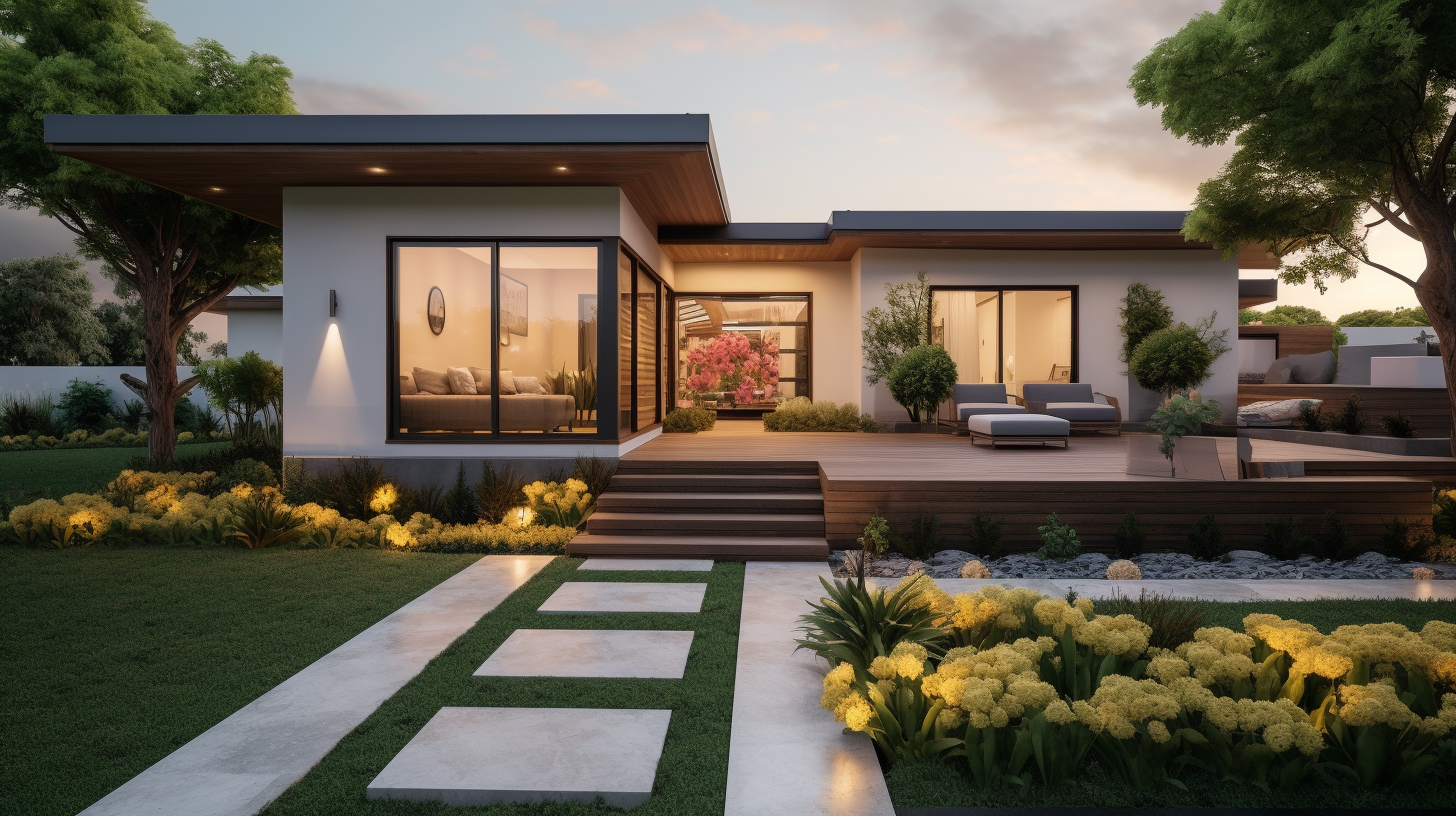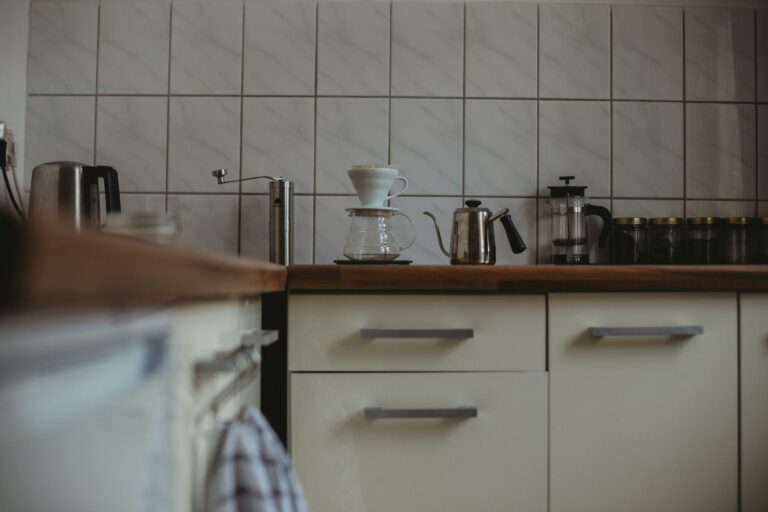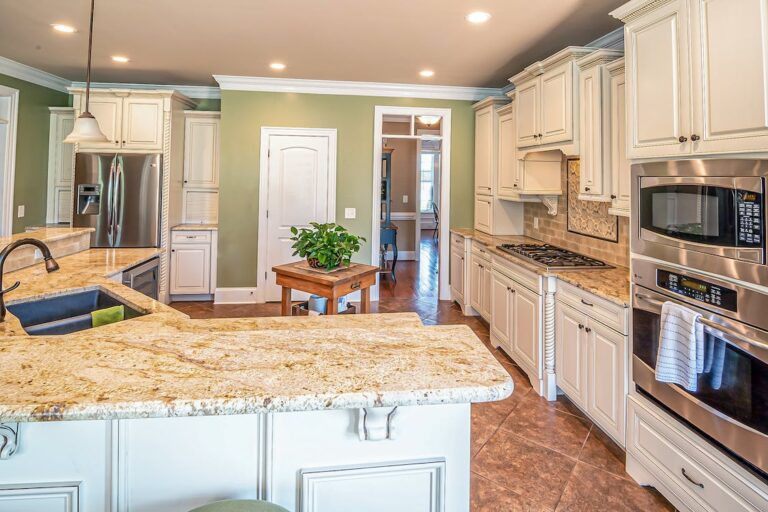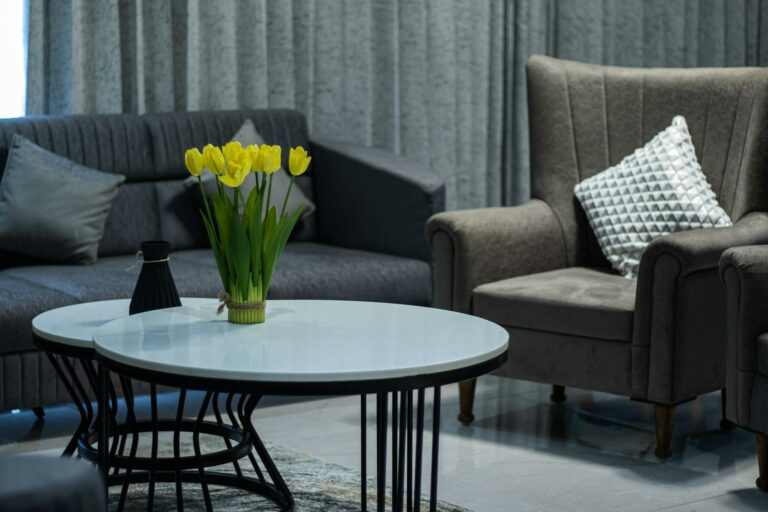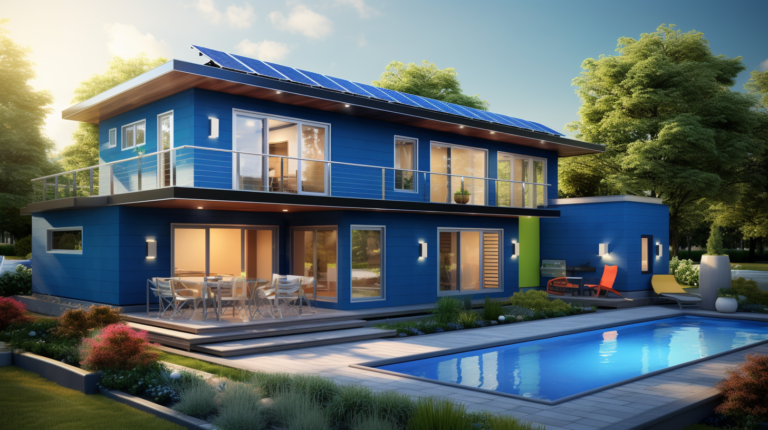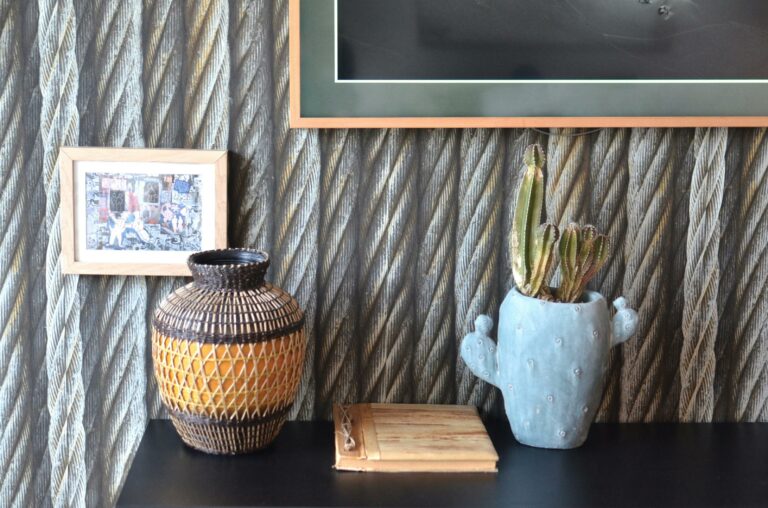Exterior Design Trends: Enhancing Your Home’s Curb Appeal in 2023
Welcome to the world of exterior design trends! Your home’s exterior is the first thing people see, and it sets the tone for your entire property. Whether you’re looking to sell your home or simply want to enhance its curb appeal, investing in exterior design is a great way to make a lasting impression.
In this article, we’ll explore the latest trends in exterior design and provide you with valuable tips and ideas to help you transform your home’s façade. From choosing the right color palette to upgrading your exterior finishes, adding architectural details, and improving your outdoor living spaces, we’ve got you covered.
So, let’s dive in and discover how you can create an eye-catching and welcoming exterior that will make your home the envy of the neighborhood!
Table of Contents
- 1 Importance of Curb Appeal in Exterior Design Trends
- 2 Choosing the Right Exterior Color Palette
- 3 Enhancing the Front Yard
- 4 Upgrading the Exterior Finishes
- 5 Adding Architectural Details
- 6 Improving the Driveway and Walkways
- 7 Outdoor Living Spaces
- 8 Boosting Energy Efficiency
- 9 Conclusion
- 10 Frequently Asked Questions
Importance of Curb Appeal in Exterior Design Trends

When it comes to your home, first impressions matter. And that’s where curb appeal comes in. Curb appeal refers to the attractiveness of the exterior of your house, particularly its appearance from the street. It sets the tone for what visitors can expect as they step foot inside your home. But its importance goes beyond just making a good impression. Here are some reasons why curb appeal is essential:
- Enhances Home Value: A well-maintained and visually appealing exterior can significantly increase the value of your home. In fact, studies have shown that homes with excellent curb appeal can sell for up to 20% more than similar properties with a less appealing exterior. So if you’re thinking of selling your home in the future, investing in curb appeal is a smart move.
- Attracts Potential Buyers: When potential buyers are browsing through real estate listings or driving by houses, they are more likely to stop and take a closer look at a home that has eye-catching curb appeal. It creates a positive first impression and sparks their interest to explore further.
- Makes a Statement: Your home’s exterior reflects your personal style and taste. A well-designed and visually pleasing facade can set your home apart from the others in your neighborhood. It shows that you take pride in your property and creates a sense of pride for you as well.
- Creates a Welcoming Atmosphere: A visually appealing exterior creates a warm and inviting environment for both residents and guests. It sets the stage for the overall experience of being in your home. Whether you’re hosting a gathering or welcoming friends and family, a beautiful exterior creates a positive and welcoming atmosphere.
- Boosts Neighborhood Appeal: Curb appeal goes beyond just your home. It also contributes to the overall appearance of your neighborhood. When homes in a community have well-maintained exteriors, it creates a sense of pride and can even attract new residents. Maintaining curb appeal not only benefits you but also benefits your neighbors and the community as a whole.
So, whether you’re looking to sell your home, create a welcoming environment for guests, or simply take pride in your property, enhancing your home’s curb appeal is undoubtedly worth the effort. Next, we’ll explore how you can choose the right exterior color palette to give your home a fresh and modern look.
Choosing the Right Exterior Color Palette

The color of your home’s exterior can make a big impact on its overall appearance. Choosing the right color palette can enhance your home’s curb appeal and create a welcoming and inviting atmosphere. Here are some tips to help you choose the perfect exterior color palette for your home:
Current Color Trends
Keeping up with the latest color trends can give your home a modern and stylish look. Some popular exterior color trends to consider include:
- Neutral Colors: Neutrals like white, gray, and beige are versatile and timeless choices that can give your home a clean and elegant look.
- Earthy Tones: Colors inspired by nature, such as greens, browns, and earthy reds, can create a warm and inviting feel.
- Bold Accents: Adding a pop of color with bold accents can make your home stand out. Consider using vibrant shades of blue, green, or even a bold red door.
Considerations for Your Home’s Architecture
The architectural style of your home should also influence your color palette choice. Here are some considerations based on different architectural styles:
- Traditional Homes: For traditional homes, classic color combinations like white with black or dark blue accents can create a timeless and elegant look.
- Modern Homes: Modern homes often look great with a monochromatic color scheme or a combination of neutral colors with bold, contrasting accents.
- Victorian Homes: Victorian homes often feature vibrant and eye-catching colors. Consider using rich hues like deep reds, greens, or blues to complement the intricate details of the architecture.
Coordinating with the Neighborhood
While it’s important for your home to stand out, you’ll also want to consider the overall aesthetic of your neighborhood. Here are a few tips for coordinating your color palette with the surrounding homes:
- Observe the Neighborhood: Take a walk around your neighborhood and observe the colors used on nearby homes. Try to choose colors that harmonize with the predominant color schemes in the area.
- Stay Complementary: If your neighbors have homes with warm colors, consider using cool colors to create a pleasing contrast. Alternatively, if neighboring homes are predominantly cool-colored, warm colors can help your home stand out.
Remember that the colors you choose for your home’s exterior should reflect your personal style while also harmonizing with the architectural style and neighborhood. It’s always a good idea to test paint samples on a small area of your home’s exterior before committing to a color scheme.
“Choosing the right color palette for your home’s exterior is like choosing the perfect outfit. It should reflect your style and make you feel confident about your home’s appearance.”
Enhancing the Front Yard

The front yard is the first thing people see when they approach your home. It sets the tone for your property and plays a crucial role in enhancing curb appeal. A well-designed and maintained front yard can make a lasting impression on visitors, potential buyers, and even passersby. Here are some tips to help you enhance your front yard and create an inviting entrance for your home:
Landscaping Ideas
- Add Some Greenery: Incorporate plants, shrubs, and flowers to add color and freshness to your front yard. Choose plants that thrive in your climate and require minimal maintenance.
- Create Visual Interest with Layers: Use different heights and layers of plants and flowers to create visual interest and add dimension to your front yard. This creates a more appealing and dynamic landscape.
- Consider the Seasonal Aspect: Select plants that bloom at different times of the year to ensure that your front yard looks appealing all year round. This will ensure that there is always something vibrant and beautiful to greet visitors.
Creating an Inviting Front Entrance
- Focus on the Front Door: Make your front door the focal point of your front yard. Paint it in a bold color that complements the overall color scheme of your home. Consider adding decorative elements such as a unique door knocker or stylish handles.
- Make it Welcoming: Add a cozy and inviting touch by placing a welcome mat and potted plants near the front entrance. This creates a warm and inviting atmosphere for guests as soon as they arrive.
- Keep it Clean and Tidy: Regularly sweep the front porch, clean the windows, and remove any clutter or debris. A clean and well-maintained entrance gives the impression that the rest of the house is well-cared for.
Adding Outdoor Lighting
- Illuminate the Pathways: Consider adding pathway lighting to guide visitors to your front door. Use solar-powered or LED lights that are energy-efficient and create a warm and welcoming ambiance.
- Highlight Architectural Features: Use spotlighting or uplighting to showcase architectural features of your home, such as columns or unique architectural details. This adds drama and visual interest to your front yard.
- Use Accent Lighting: Use accent lighting to highlight trees, plants, and other points of interest in your front yard. This creates a beautiful and inviting ambiance, especially in the evenings.
By implementing these ideas, you can transform your front yard into a beautiful and inviting space that enhances the curb appeal of your home. Remember to choose plants and materials that align with your overall exterior design and consider the maintenance requirements to ensure your front yard stays looking its best.
Upgrading the Exterior Finishes

The exterior finishes of your home play a vital role in enhancing its overall curb appeal. Upgrading these finishes can give your home a fresh and modern look. Here are some ideas to consider when upgrading the exterior finishes of your home:
1. Siding and Cladding Options
The right choice of siding and cladding can instantly transform the appearance of your home. Some popular options to consider are:
- Vinyl siding: It is low maintenance and comes in a variety of colors and styles.
- Fiber cement siding: It provides durability and can mimic the look of wood, stucco, or even stone.
- Brick or stone cladding: Adding a brick or stone veneer can give your home a classic and timeless appeal.
2. Renewing the Roof
A well-maintained and visually appealing roof is essential for the overall look of your home. Consider options such as:
- Asphalt shingles: They are cost-effective and come in a wide range of colors and styles.
- Metal roofing: It offers durability and can give your home a modern and sleek appearance.
- Tile or slate roofing: These materials provide a luxurious and elegant look but may be more expensive.
3. Windows and Doors
Upgrading your windows and doors can greatly enhance the aesthetic value of your home. Consider the following:
- Energy-efficient windows: They not only improve the appearance but also help in reducing energy costs.
- Custom-designed doors: Opt for doors that match the architectural style of your home and add character.
- Adding decorative glass inserts or sidelights: These can add a touch of elegance and uniqueness to your entryway.
Remember, when selecting the finishes for your home’s exterior, it’s important to consider the overall architectural style and the surrounding neighborhood. You want the upgrades to harmonize with the existing aesthetic while still making a statement.
“Upgrading the exterior finishes of your home can give it a fresh and modern look.”
“Consider options such as vinyl siding, fiber cement siding, brick or stone cladding for a transformational effect.”
“Investing in a visually appealing roof and upgrading windows and doors can greatly enhance the curb appeal.”
Adding Architectural Details

When it comes to enhancing your home’s curb appeal, adding architectural details can make a big impact. These details not only add visual interest to your home’s exterior but also contribute to its overall charm and character. Whether your home is modern or traditional, there are various architectural elements that can elevate its design and make it stand out in the neighborhood. Here are some ideas to consider:
Decorative Trims and Molding
Decorative trims and molding can add depth and sophistication to your home’s exterior. These architectural details can be added around windows, doors, and along the roofline. They come in a variety of styles and finishes, allowing you to choose the ones that complement your home’s architectural style. From classic crown molding to intricate scrollwork, the options are endless. These details not only enhance the aesthetic appeal but also serve as a protective barrier against the elements.
Shutters and Window Boxes
Adding shutters to your home’s exterior can instantly transform its appearance. Shutters come in many styles, from traditional louvered shutters to charming cottage-style shutters. They not only add visual interest but also provide privacy and shade. Consider painting them in a contrasting color to make them pop against the facade of your home.
Window boxes are another architectural detail that can bring life and color to your home’s exterior. By adding flowers and greenery, you can create a welcoming and charming look. Choose flowers and plants that thrive in your climate and complement the overall color scheme of your home.
Front Porch or Veranda
If you have the space, adding a front porch or veranda can create an inviting entrance and provide additional outdoor living space. This architectural feature can serve as a cozy spot to relax, socialize, and enjoy the outdoors. Consider adding comfortable seating, outdoor lighting, and decorative accents to create a warm and inviting atmosphere. Whether it’s a small porch or a sprawling veranda, this addition can greatly enhance the curb appeal of your home.
When adding architectural details to your home’s exterior, it’s important to consider the overall style and architecture of your house. Ensure that the details you choose complement the existing design and do not clash with neighboring homes. Remember, the goal is to enhance your home’s curb appeal and create a visually cohesive look.
Adding architectural details can take your home’s exterior to the next level. From decorative trims and molding to shutters and window boxes, these details can add charm and character to your home’s facade. Consider the style and architecture of your house, and choose elements that enhance its overall aesthetic appeal. With the right architectural details, you can create a stunning and inviting exterior that will make your home the envy of the neighborhood.
Improving the Driveway and Walkways

When it comes to enhancing your home’s curb appeal, don’t forget about your driveway and walkways! These areas are often overlooked, but they play a significant role in making a positive first impression. By improving the driveway and walkways, you can create a welcoming and aesthetically pleasing entrance to your home. Here are some tips to help you get started:
Choosing the Right Materials
The first step in improving your driveway and walkways is selecting the right materials. The material you choose should not only complement the style of your home but also be practical and durable. Here are some popular options to consider:
- Concrete: Concrete is a versatile and cost-effective choice for driveways and walkways. It can be stamped or stained to mimic the appearance of more expensive materials like brick or stone.
- Brick: Brick offers a classic and timeless look. It is known for its durability and can add a touch of elegance to your home’s exterior.
- Pavers: Pavers are a popular choice for walkways as they come in various shapes, sizes, and colors. They allow for easy customization and can create unique patterns and designs.
- Gravel: Gravel driveways can add a rustic and natural charm to your home. They are relatively low maintenance and provide good drainage.
Creating a Paved or Stone Pathway
Once you’ve chosen the right materials, it’s time to create a paved or stone pathway. Here are some considerations to keep in mind:
- Layout: Plan the layout of your pathway carefully. Consider the flow of traffic and create a logical path that leads to your front entrance.
- Width: Ensure that your pathway is wide enough to accommodate at least two people walking side by side comfortably.
- Leveling: Make sure the pathway is properly leveled to prevent tripping hazards. Slopes should be gentle and provide easy access for everyone, including those with mobility challenges.
- Edging: Add edging to your pathway to give it a polished and finished look. This can be done with bricks, stones, or other decorative materials.
Incorporating Decorative Features
To truly enhance your driveway and walkways, consider incorporating decorative features that add visual interest and charm. Here are some ideas:
- Lighting: Install outdoor lighting along your driveway and walkways to improve visibility and create a warm and inviting ambiance.
- Planters: Add planters along your walkways filled with colorful flowers and plants. This can create a vibrant and welcoming atmosphere.
- Fencing or Gates: If you have a long driveway, consider adding a decorative fence or gate at the entrance. This can add an extra layer of elegance and security to your home.
- Arbors or Trellises: For a touch of whimsy, consider adding arbors or trellises along your pathway. These structures can be adorned with climbing plants, creating a beautiful and enchanting walkway.
By improving your driveway and walkways, you can greatly enhance your home’s curb appeal. Remember to choose the right materials, create a well-designed pathway, and incorporate decorative features that reflect your personal style. With these simple enhancements, you’ll have a stunning entrance that will impress your guests and make you proud to call it home.
Outdoor Living Spaces

When it comes to enhancing your home’s curb appeal, don’t overlook the importance of creating beautiful and functional outdoor living spaces. These areas not only provide you with a place to enjoy the outdoors but also add value to your home. Whether you have a small backyard or a sprawling lawn, there are countless ways to transform your outdoor space into a welcoming oasis. Here are some ideas to inspire you:
Patio and Deck Designs
- A patio or deck is a versatile addition to any outdoor space. It provides a designated area for relaxation and entertainment.
- Consider the layout and size of your outdoor space when designing your patio or deck. Choose materials that complement your home’s exterior and create a cohesive look.
- Incorporate features like a fire pit or outdoor kitchen to make your patio or deck even more inviting.
- Don’t forget to add comfortable seating and outdoor furniture that can withstand the elements. Cushions and pillows in coordinating colors can add a pop of personality to the space.
Outdoor Furniture and Accessories
- Choosing the right outdoor furniture is important for creating a comfortable and stylish outdoor living space. Opt for durable materials like teak or aluminum that can withstand the elements.
- Consider the functionality of the furniture. For example, if you plan on dining outdoors, a dining table and chairs are essential. If you prefer lounging, a sectional sofa or chaise lounges may be more suitable.
- Accessories such as outdoor rugs, throw pillows, and decorative lanterns can add a touch of style and create a cozy atmosphere.
- Don’t forget about shade options like umbrellas, pergolas, or retractable awnings to provide relief from the sun.
Garden and Greenery
- Add beauty and privacy to your outdoor living space by incorporating lush greenery.
- Plant a variety of flowers, shrubs, and trees that will thrive in your climate. Consider adding container gardens for added flexibility and color.
- Incorporate vertical gardens or trellises to maximize space and create a focal point.
- Add lighting to highlight your garden at night and create a magical ambiance.
Creating a welcoming and functional outdoor living space is a great way to enhance your home’s curb appeal and increase its value. With the right design and attention to detail, you can transform your outdoor area into a retreat that you and your family will love spending time in. So, grab a cold drink, kick back, and enjoy the beauty of your new outdoor oasis!
Boosting Energy Efficiency

In today’s world, energy efficiency is becoming increasingly important as we strive to reduce our carbon footprint and save on energy costs. When it comes to your home’s exterior design, there are several ways you can boost its energy efficiency. Not only will these improvements help the environment, but they will also enhance the overall comfort and value of your home.
Insulation and Weatherproofing
One of the most important aspects of energy efficiency is proper insulation and weatherproofing. By insulating your home’s exterior walls, roof, and foundation, you can prevent heat transfer and keep your home cool in the summer and warm in the winter. Insulation also helps to reduce noise pollution from the outside.
Weatherproofing your home involves sealing any gaps or cracks in your exterior walls, windows, and doors. This prevents air leakage, which can lead to energy loss and increased energy bills. Common areas to check for drafts include around windows and doors, electrical outlets, and vents.
Energy-Efficient Windows
Windows play a significant role in the energy efficiency of your home. Upgrading to energy-efficient windows can help to reduce heat gain in the summer and heat loss in the winter. Look for windows with low-emissivity (low-E) glass, which has a special coating that reflects heat while still allowing natural light to enter your home.
Double or triple-pane windows with gas-filled chambers between the panes provide better insulation than single-pane windows. Additionally, windows with energy-efficient frames, such as vinyl or fiberglass, offer better thermal performance and durability compared to traditional aluminum frames.
Solar Panels and Sustainable Solutions
Harnessing the power of the sun is an excellent way to boost your home’s energy efficiency. Installing solar panels on your roof can generate clean, renewable energy to power your home. This reduces your reliance on traditional energy sources and can even result in savings on your energy bills.
In addition to solar panels, there are other sustainable solutions you can incorporate into your home’s exterior design. For example, consider using rainwater harvesting systems to collect and reuse rainwater for irrigation purposes. Planting trees strategically around your home can provide natural shade and reduce the need for air conditioning.
By implementing these energy-efficient measures, you can significantly reduce your home’s energy consumption and contribute to a greener planet. Not only will you be saving money on energy bills, but you will also be adding value to your home and creating a more comfortable living environment.
“Improving your home’s energy efficiency doesn’t have to be complicated. Simple upgrades such as insulation, energy-efficient windows, and solar panels can go a long way in reducing your environmental impact and saving money in the long run.”
Conclusion
In conclusion, enhancing your home’s curb appeal not only adds beauty and appeal to your property but also increases its value. By employing the right exterior design trends and making thoughtful improvements, you can create a welcoming and visually stunning home exterior.
Remember these key takeaways:
- Curb appeal plays a crucial role in making a positive first impression on visitors and potential buyers.
- Choosing the right exterior color palette involves considering current trends, your home’s architecture, and coordinating with the neighborhood.
- Enhancing the front yard includes landscaping ideas, creating an inviting front entrance, and adding outdoor lighting.
- Upgrading the exterior finishes, such as siding, roofing, and windows and doors, can greatly transform the look of your home.
- Adding architectural details like trims, shutters, and front porches adds character and charm.
- Improving the driveway and walkways with the right materials and incorporating decorative features can enhance the overall aesthetic.
- Outdoor living spaces, such as patios, decks, and gardens, provide additional areas for relaxation and entertainment.
- Boosting energy efficiency through insulation, energy-efficient windows, and sustainable solutions not only benefits the environment but also saves you money in the long run.
By incorporating these ideas and trends, you can transform your home’s exterior into a beautiful and inviting space. Don’t be afraid to get creative and showcase your personal style. Remember to maintain and update your exterior regularly to ensure it remains fresh and appealing to future onlookers.
So go ahead and make the most of your home’s curb appeal. With a little effort and attention to detail, you can create a stunning exterior that will make you proud to call your house a home.
Also read; Transform Your Kitchen with a Fresh Coat of Paint: Color Ideas and Tips in 2023
Frequently Asked Questions
- What are some popular exterior design trends for enhancing curb appeal?Some popular exterior design trends for enhancing curb appeal include: 1. Incorporating natural elements like stone or wood, 2. Adding pops of color through vibrant front doors or decorative accents, 3. Installing outdoor lighting to highlight architectural features, 4. Creating an inviting outdoor seating area, and 5. Using landscaping to add depth and texture to your home’s exterior.
- How can I incorporate natural elements in my home’s exterior design?You can incorporate natural elements in your home’s exterior design by using materials like stone or wood for siding, adding a wood or stone accent wall, incorporating plants and greenery, or installing natural stone pathways or a wooden deck or porch.
- What color should I choose for my front door to enhance curb appeal?Choosing a vibrant color for your front door can help enhance curb appeal. Popular choices include bright red, navy blue, dark green, coral, or even a unique color that complements the overall exterior color scheme of your home.
- How can outdoor lighting improve the curb appeal of my home?Outdoor lighting can improve the curb appeal of your home by highlighting architectural features, creating a warm and inviting ambiance, increasing safety and security, and providing visual interest during nighttime. Consider using uplights to showcase trees or architectural details, installing pathway lights, or adding decorative string lights for a cozy atmosphere.
- What are some landscaping ideas to enhance curb appeal?Some landscaping ideas to enhance curb appeal include: planting colorful flowers and shrubs, creating a well-maintained lawn, adding mulch or decorative rocks, installing a charming garden fence, using potted plants or hanging baskets, and strategically placing trees or bushes to frame your home.

